Consider This Animal Cell. What Is The Function Of The Organelles That Are Labeled F?
Affiliate iii: Introduction to Cell Structure and Function
3.3 Eukaryotic Cells
By the end of this section, you will exist able to:
- Describe the structure of eukaryotic institute and animal cells
- State the role of the plasma membrane
- Summarize the functions of the major cell organelles
- Depict the cytoskeleton and extracellular matrix
Watch a video about oxygen in the atmosphere.
At this point, information technology should be clear that eukaryotic cells have a more complex structure than exercise prokaryotic cells. Organelles let for various functions to occur in the cell at the same time. Before discussing the functions of organelles inside a eukaryotic cell, let usa first examine 2 of import components of the cell: the plasma membrane and the cytoplasm.
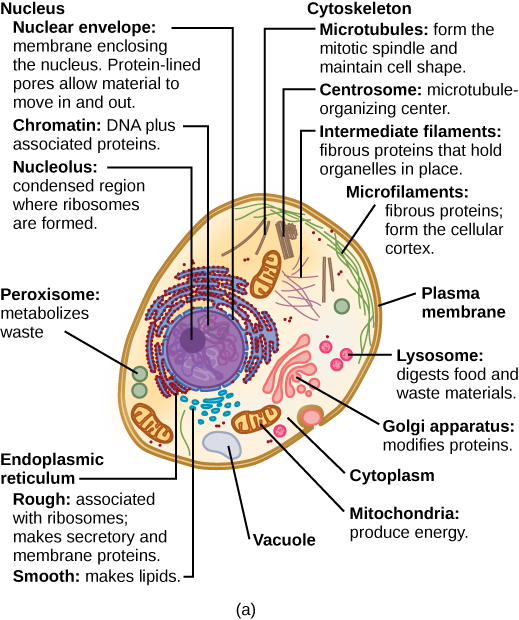
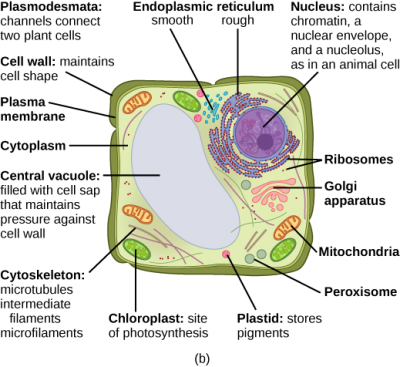
What structures does a plant cell have that an animal prison cell does not have? What structures does an animal cell have that a plant cell does not accept? Found cells have plasmodesmata, a cell wall, a large central vacuole, chloroplasts, and plastids. Beast cells take lysosomes and centrosomes.
The Plasma Membrane
Like prokaryotes, eukaryotic cells have a plasma membrane (Figure three.9) made upwards of a phospholipid bilayer with embedded proteins that separates the internal contents of the cell from its surrounding environment. A phospholipid is a lipid molecule equanimous of ii fatty acid chains, a glycerol backbone, and a phosphate group. The plasma membrane regulates the passage of some substances, such equally organic molecules, ions, and water, preventing the passage of some to maintain internal conditions, while actively bringing in or removing others. Other compounds move passively across the membrane.
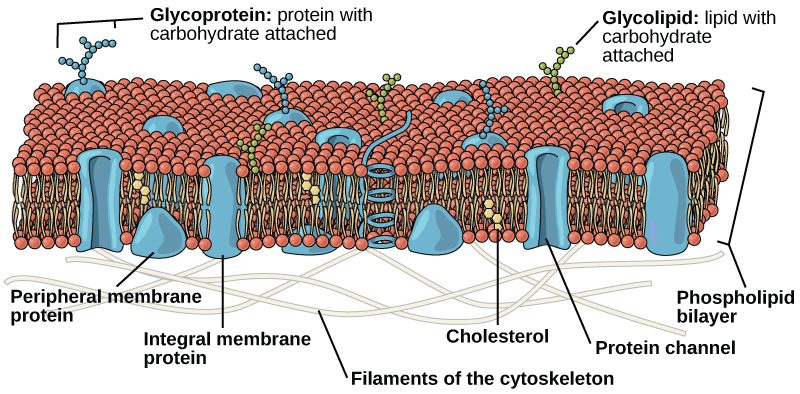
The plasma membranes of cells that specialize in absorption are folded into fingerlike projections called microvilli (singular = microvillus). This folding increases the surface expanse of the plasma membrane. Such cells are typically constitute lining the small-scale intestine, the organ that absorbs nutrients from digested food. This is an excellent instance of form matching the function of a construction.
People with celiac disease have an immune response to gluten, which is a protein constitute in wheat, barley, and rye. The immune response damages microvilli, and thus, afflicted individuals cannot absorb nutrients. This leads to malnutrition, cramping, and diarrhea. Patients suffering from celiac disease must follow a gluten-free diet.
The Cytoplasm
The cytoplasm comprises the contents of a jail cell between the plasma membrane and the nuclear envelope (a structure to be discussed shortly). Information technology is made up of organelles suspended in the gel-like cytosol, the cytoskeleton, and diverse chemicals. Fifty-fifty though the cytoplasm consists of lxx to lxxx pct water, it has a semi-solid consistency, which comes from the proteins within information technology. Yet, proteins are not the only organic molecules institute in the cytoplasm. Glucose and other unproblematic sugars, polysaccharides, amino acids, nucleic acids, fatty acids, and derivatives of glycerol are found in that location too. Ions of sodium, potassium, calcium, and many other elements are also dissolved in the cytoplasm. Many metabolic reactions, including protein synthesis, accept identify in the cytoplasm.
The Cytoskeleton
If you were to remove all the organelles from a cell, would the plasma membrane and the cytoplasm be the only components left? No. Within the cytoplasm, there would nonetheless be ions and organic molecules, plus a network of protein fibers that helps to maintain the shape of the cell, secures certain organelles in specific positions, allows cytoplasm and vesicles to move inside the cell, and enables unicellular organisms to move independently. Collectively, this network of protein fibers is known every bit the cytoskeleton. At that place are three types of fibers within the cytoskeleton: microfilaments, also known as actin filaments, intermediate filaments, and microtubules (Figure iii.10).
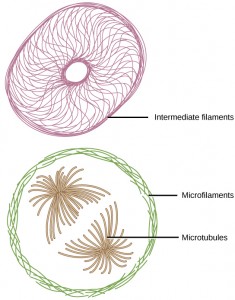
Microfilaments are the thinnest of the cytoskeletal fibers and office in moving cellular components, for case, during jail cell division. They also maintain the construction of microvilli, the all-encompassing folding of the plasma membrane found in cells dedicated to absorption. These components are also common in muscle cells and are responsible for musculus cell contraction. Intermediate filaments are of intermediate bore and accept structural functions, such equally maintaining the shape of the cell and anchoring organelles. Keratin, the compound that strengthens hair and nails, forms i blazon of intermediate filament. Microtubules are the thickest of the cytoskeletal fibers. These are hollow tubes that can dissolve and reform quickly. Microtubules guide organelle motility and are the structures that pull chromosomes to their poles during cell sectionalisation. They are likewise the structural components of flagella and cilia. In cilia and flagella, the microtubules are organized equally a circumvolve of ix double microtubules on the outside and two microtubules in the middle.
The centrosome is a region near the nucleus of animal cells that functions as a microtubule-organizing center. It contains a pair of centrioles, ii structures that lie perpendicular to each other. Each centriole is a cylinder of nine triplets of microtubules.
The centrosome replicates itself before a jail cell divides, and the centrioles play a office in pulling the duplicated chromosomes to opposite ends of the dividing jail cell. However, the exact function of the centrioles in prison cell division is non articulate, since cells that take the centrioles removed can still carve up, and plant cells, which lack centrioles, are capable of prison cell partitioning.
Flagella and Cilia
Flagella (singular = flagellum) are long, hair-like structures that extend from the plasma membrane and are used to move an unabridged cell, (for example, sperm, Euglena). When nowadays, the cell has simply i flagellum or a few flagella. When cilia (singular = cilium) are present, nonetheless, they are many in number and extend forth the entire surface of the plasma membrane. They are brusk, pilus-like structures that are used to move entire cells (such as paramecium) or move substances along the outer surface of the cell (for instance, the cilia of cells lining the fallopian tubes that move the ovum toward the uterus, or cilia lining the cells of the respiratory tract that move particulate thing toward the throat that mucus has trapped).
The Endomembrane System
The endomembrane system (endo = within) is a grouping of membranes and organelles in eukaryotic cells that work together to modify, package, and ship lipids and proteins. Information technology includes the nuclear envelope, lysosomes, vesicles, endoplasmic reticulum and the Golgi apparatus, which we will cover soon. Although not technically within the cell, the plasma membrane is included in the endomembrane system because, as y'all will meet, it interacts with the other endomembranous organelles.
The Nucleus
Typically, the nucleus is the well-nigh prominent organelle in a cell. The nucleus (plural = nuclei) houses the cell's DNA in the form of chromatin and directs the synthesis of ribosomes and proteins. Let usa look at it in more particular (Effigy three.11).
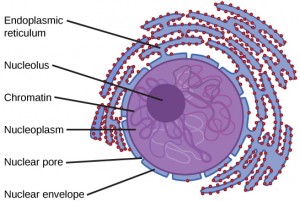
The nuclear envelope is a double-membrane construction that constitutes the outermost portion of the nucleus (Effigy 3.11). Both the inner and outer membranes of the nuclear envelope are phospholipid bilayers.
The nuclear envelope is punctuated with pores that command the passage of ions, molecules, and RNA between the nucleoplasm and the cytoplasm.
To understand chromatin, it is helpful to first consider chromosomes. Chromosomes are structures within the nucleus that are made upwards of Dna, the hereditary textile, and proteins. This combination of Deoxyribonucleic acid and proteins is called chromatin. In eukaryotes, chromosomes are linear structures. Every species has a specific number of chromosomes in the nucleus of its body cells. For example, in humans, the chromosome number is 46, whereas in fruit flies, the chromosome number is viii.
Chromosomes are merely visible and distinguishable from 1 another when the prison cell is getting prepare to dissever. When the cell is in the growth and maintenance phases of its life bicycle, the chromosomes resemble an unwound, jumbled bunch of threads.
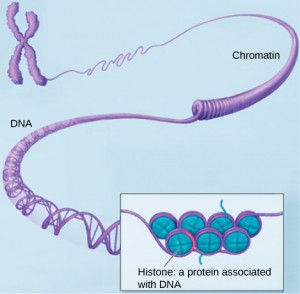
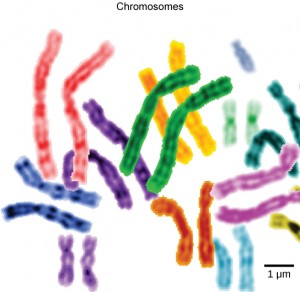
Nosotros already know that the nucleus directs the synthesis of ribosomes, but how does it do this? Some chromosomes accept sections of DNA that encode ribosomal RNA. A darkly stained area within the nucleus, called the nucleolus (plural = nucleoli), aggregates the ribosomal RNA with associated proteins to assemble the ribosomal subunits that are then transported through the nuclear pores into the cytoplasm.
The Endoplasmic Reticulum
The endoplasmic reticulum (ER) is a series of interconnected membranous tubules that collectively modify proteins and synthesize lipids. Nevertheless, these two functions are performed in split up areas of the endoplasmic reticulum: the rough endoplasmic reticulum and the smooth endoplasmic reticulum, respectively.
The hollow portion of the ER tubules is chosen the lumen or cisternal infinite. The membrane of the ER, which is a phospholipid bilayer embedded with proteins, is continuous with the nuclear envelope.
The crude endoplasmic reticulum (RER) is and then named because the ribosomes attached to its cytoplasmic surface requite it a studded appearance when viewed through an electron microscope.
The ribosomes synthesize proteins while fastened to the ER, resulting in the transfer of their newly synthesized proteins into the lumen of the RER where they undergo modifications such as folding or improver of sugars. The RER also makes phospholipids for cell membranes.
If the phospholipids or modified proteins are non destined to stay in the RER, they will be packaged inside vesicles and transported from the RER past budding from the membrane. Since the RER is engaged in modifying proteins that will be secreted from the prison cell, information technology is abundant in cells that secrete proteins, such every bit the liver.
The smooth endoplasmic reticulum (SER) is continuous with the RER but has few or no ribosomes on its cytoplasmic surface. The SER's functions include synthesis of carbohydrates, lipids (including phospholipids), and steroid hormones; detoxification of medications and poisons; alcohol metabolism; and storage of calcium ions.
The Golgi Appliance
Nosotros take already mentioned that vesicles can bud from the ER, but where exercise the vesicles go? Before reaching their final destination, the lipids or proteins within the ship vesicles need to be sorted, packaged, and tagged so that they wind up in the right place. The sorting, tagging, packaging, and distribution of lipids and proteins take place in the Golgi apparatus (also chosen the Golgi body), a series of flattened membranous sacs.
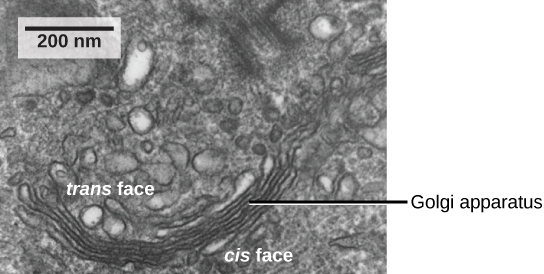
The Golgi apparatus has a receiving face about the endoplasmic reticulum and a releasing confront on the side away from the ER, toward the prison cell membrane. The transport vesicles that course from the ER travel to the receiving confront, fuse with it, and empty their contents into the lumen of the Golgi apparatus. As the proteins and lipids travel through the Golgi, they undergo further modifications. The most frequent modification is the improver of short chains of sugar molecules. The newly modified proteins and lipids are then tagged with small molecular groups to enable them to exist routed to their proper destinations.
Finally, the modified and tagged proteins are packaged into vesicles that bud from the reverse face of the Golgi. While some of these vesicles, transport vesicles, eolith their contents into other parts of the cell where they will exist used, others, secretory vesicles, fuse with the plasma membrane and release their contents outside the cell.
The amount of Golgi in dissimilar jail cell types once again illustrates that form follows function within cells. Cells that engage in a neat deal of secretory activity (such every bit cells of the salivary glands that secrete digestive enzymes or cells of the allowed system that secrete antibodies) have an abundant number of Golgi.
In plant cells, the Golgi has an boosted role of synthesizing polysaccharides, some of which are incorporated into the cell wall and some of which are used in other parts of the jail cell.
Lysosomes
In fauna cells, the lysosomes are the cell's "garbage disposal." Digestive enzymes inside the lysosomes assistance the breakup of proteins, polysaccharides, lipids, nucleic acids, and even worn-out organelles. In single-celled eukaryotes, lysosomes are important for digestion of the nutrient they ingest and the recycling of organelles. These enzymes are active at a much lower pH (more acidic) than those located in the cytoplasm. Many reactions that take identify in the cytoplasm could not occur at a low pH, thus the advantage of compartmentalizing the eukaryotic prison cell into organelles is apparent.
Lysosomes as well use their hydrolytic enzymes to destroy affliction-causing organisms that might enter the cell. A good example of this occurs in a grouping of white blood cells chosen macrophages, which are part of your body'due south allowed organization. In a procedure known equally phagocytosis, a section of the plasma membrane of the macrophage invaginates (folds in) and engulfs a pathogen. The invaginated section, with the pathogen within, then pinches itself off from the plasma membrane and becomes a vesicle. The vesicle fuses with a lysosome. The lysosome'southward hydrolytic enzymes so destroy the pathogen (Figure 3.15).
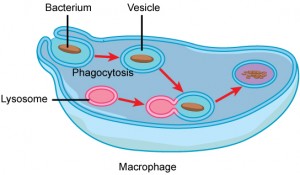
Vesicles and Vacuoles
Vesicles and vacuoles are membrane-bound sacs that function in storage and send. Vacuoles are somewhat larger than vesicles, and the membrane of a vacuole does not fuse with the membranes of other cellular components. Vesicles can fuse with other membranes inside the prison cell system. Additionally, enzymes inside plant vacuoles tin break down macromolecules.
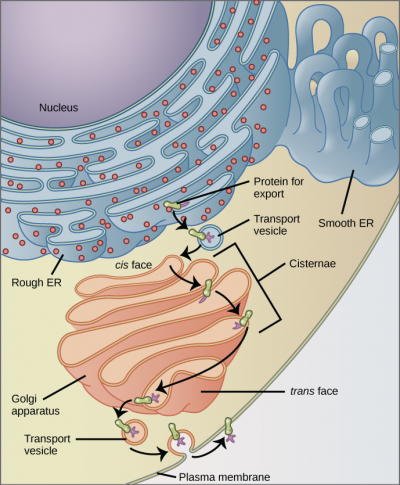
Why does the cis face of the Golgi not face up the plasma membrane?
<!– Because that face receives chemicals from the ER, which is toward the center of the cell. –>
Ribosomes
Ribosomes are the cellular structures responsible for poly peptide synthesis. When viewed through an electron microscope, gratuitous ribosomes appear every bit either clusters or single tiny dots floating freely in the cytoplasm. Ribosomes may be attached to either the cytoplasmic side of the plasma membrane or the cytoplasmic side of the endoplasmic reticulum. Electron microscopy has shown that ribosomes consist of large and small subunits. Ribosomes are enzyme complexes that are responsible for protein synthesis.
Because poly peptide synthesis is essential for all cells, ribosomes are found in practically every prison cell, although they are smaller in prokaryotic cells. They are particularly abundant in immature red blood cells for the synthesis of hemoglobin, which functions in the transport of oxygen throughout the body.
Mitochondria
Mitochondria (atypical = mitochondrion) are often called the "powerhouses" or "energy factories" of a cell because they are responsible for making adenosine triphosphate (ATP), the cell'south master free energy-carrying molecule. The formation of ATP from the breakdown of glucose is known as cellular respiration. Mitochondria are oval-shaped, double-membrane organelles (Figure 3.17) that accept their own ribosomes and Deoxyribonucleic acid. Each membrane is a phospholipid bilayer embedded with proteins. The inner layer has folds chosen cristae, which increase the surface area of the inner membrane. The expanse surrounded by the folds is called the mitochondrial matrix. The cristae and the matrix have different roles in cellular respiration.
In keeping with our theme of course post-obit role, it is important to point out that muscle cells take a very high concentration of mitochondria because muscle cells need a lot of free energy to contract.
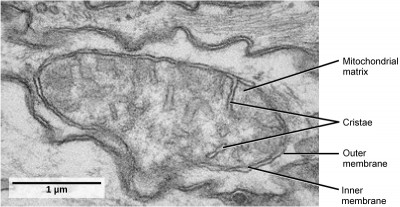
Peroxisomes
Peroxisomes are small, round organelles enclosed by single membranes. They carry out oxidation reactions that break down fatty acids and amino acids. They too detoxify many poisons that may enter the trunk. Alcohol is detoxified by peroxisomes in liver cells. A byproduct of these oxidation reactions is hydrogen peroxide, HiiO2, which is contained within the peroxisomes to foreclose the chemical from causing damage to cellular components outside of the organelle. Hydrogen peroxide is safely broken downward by peroxisomal enzymes into water and oxygen.
Creature Cells versus Plant Cells
Despite their primal similarities, there are some hit differences between animal and constitute cells (see Table 3.1). Animal cells take centrioles, centrosomes (discussed under the cytoskeleton), and lysosomes, whereas plant cells practice non. Plant cells have a cell wall, chloroplasts, plasmodesmata, and plastids used for storage, and a large cardinal vacuole, whereas animal cells practise non.
The Jail cell Wall
In Figure three.8b, the diagram of a plant cell, y'all see a structure external to the plasma membrane called the cell wall. The cell wall is a rigid covering that protects the cell, provides structural support, and gives shape to the prison cell. Fungal and protist cells also have cell walls.
While the chief component of prokaryotic jail cell walls is peptidoglycan, the major organic molecule in the plant prison cell wall is cellulose, a polysaccharide fabricated upward of long, straight chains of glucose units. When nutritional information refers to dietary fiber, it is referring to the cellulose content of food.
Chloroplasts
Like mitochondria, chloroplasts also have their own DNA and ribosomes. Chloroplasts function in photosynthesis and tin be plant in eukaryotic cells such every bit plants and algae. In photosynthesis, carbon dioxide, water, and light free energy are used to brand glucose and oxygen. This is the major divergence between plants and animals: Plants (autotrophs) are able to make their own food, like glucose, whereas animals (heterotrophs) must rely on other organisms for their organic compounds or nutrient source.
Like mitochondria, chloroplasts take outer and inner membranes, only within the space enclosed by a chloroplast's inner membrane is a gear up of interconnected and stacked, fluid-filled membrane sacs called thylakoids (Figure 3.xviii). Each stack of thylakoids is chosen a granum (plural = grana). The fluid enclosed by the inner membrane and surrounding the grana is chosen the stroma.
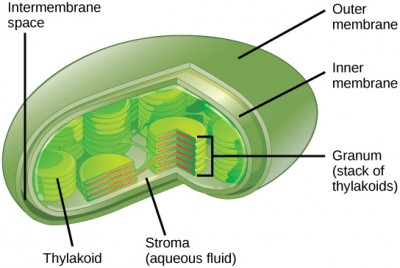
The chloroplasts contain a green pigment called chlorophyll, which captures the energy of sunlight for photosynthesis. Like constitute cells, photosynthetic protists also have chloroplasts. Some bacteria as well perform photosynthesis, just they do not have chloroplasts. Their photosynthetic pigments are located in the thylakoid membrane within the jail cell itself.
Development in Action
Endosymbiosis: Nosotros have mentioned that both mitochondria and chloroplasts comprise DNA and ribosomes. Have you wondered why? Potent evidence points to endosymbiosis as the explanation.
Symbiosis is a human relationship in which organisms from two separate species live in close association and typically exhibit specific adaptations to each other. Endosymbiosis (endo-= within) is a relationship in which one organism lives inside the other. Endosymbiotic relationships grow in nature. Microbes that produce vitamin 1000 live within the human gut. This relationship is beneficial for us because we are unable to synthesize vitamin K. It is also beneficial for the microbes because they are protected from other organisms and are provided a stable habitat and arable food by living within the large intestine.
Scientists take long noticed that leaner, mitochondria, and chloroplasts are like in size. We besides know that mitochondria and chloroplasts have DNA and ribosomes, just every bit bacteria do and they resemble the types found in bacteria. Scientists believe that host cells and bacteria formed a mutually beneficial endosymbiotic human relationship when the host cells ingested aerobic bacteria and cyanobacteria merely did not destroy them. Through evolution, these ingested leaner became more specialized in their functions, with the aerobic leaner condign mitochondria and the photosynthetic bacteria becoming chloroplasts.
The Central Vacuole
Previously, we mentioned vacuoles as essential components of plant cells. If you expect at Effigy iii.viiib, you will run into that plant cells each have a large, central vacuole that occupies most of the cell. The central vacuole plays a key office in regulating the jail cell's concentration of water in changing environmental conditions. In establish cells, the liquid inside the primal vacuole provides turgor pressure, which is the outward pressure level caused by the fluid inside the prison cell. Have you ever noticed that if you forget to h2o a plant for a few days, it wilts? That is because as the h2o concentration in the soil becomes lower than the h2o concentration in the plant, water moves out of the central vacuoles and cytoplasm and into the soil. As the primal vacuole shrinks, it leaves the prison cell wall unsupported. This loss of support to the jail cell walls of a plant results in the wilted advent. Additionally, this fluid has a very bitter sense of taste, which discourages consumption by insects and animals. The cardinal vacuole also functions to store proteins in developing seed cells.
Extracellular Matrix of Animal Cells
Well-nigh beast cells release materials into the extracellular infinite. The main components of these materials are glycoproteins and the poly peptide collagen. Collectively, these materials are called the extracellular matrix (Figure iii.xix). Not merely does the extracellular matrix hold the cells together to form a tissue, but it too allows the cells inside the tissue to communicate with each other.
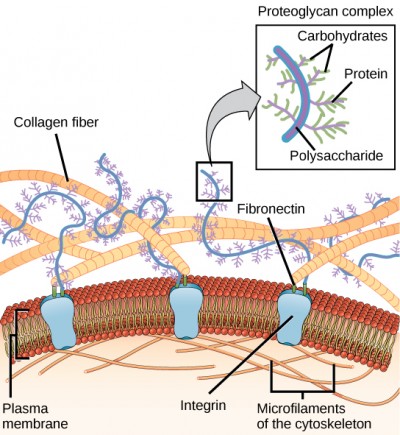
Blood clotting provides an example of the office of the extracellular matrix in cell communication. When the cells lining a blood vessel are damaged, they display a poly peptide receptor called tissue factor. When tissue cistron binds with another factor in the extracellular matrix, it causes platelets to attach to the wall of the damaged claret vessel, stimulates next polish muscle cells in the blood vessel to contract (thus constricting the blood vessel), and initiates a series of steps that stimulate the platelets to produce clotting factors.
Intercellular Junctions
Cells tin likewise communicate with each other by direct contact, referred to every bit intercellular junctions. There are some differences in the ways that plant and beast cells do this. Plasmodesmata (singular = plasmodesma) are junctions betwixt plant cells, whereas fauna cell contacts include tight and gap junctions, and desmosomes.
In general, long stretches of the plasma membranes of neighboring establish cells cannot touch i another because they are separated by the cell walls surrounding each jail cell. Plasmodesmata are numerous channels that pass between the jail cell walls of next plant cells, connecting their cytoplasm and enabling betoken molecules and nutrients to be transported from cell to cell (Effigy 3.xxa).

A tight junction is a watertight seal betwixt 2 adjacent animal cells (Figure 3.xxb). Proteins hold the cells tightly against each other. This tight adhesion prevents materials from leaking betwixt the cells. Tight junctions are typically found in the epithelial tissue that lines internal organs and cavities, and composes nigh of the skin. For example, the tight junctions of the epithelial cells lining the urinary float prevent urine from leaking into the extracellular space.
Besides found merely in fauna cells are desmosomes, which act like spot welds between adjacent epithelial cells (Figure 3.twentyc). They keep cells together in a canvas-like germination in organs and tissues that stretch, like the skin, heart, and muscles.
Gap junctions in fauna cells are like plasmodesmata in plant cells in that they are channels betwixt adjacent cells that allow for the transport of ions, nutrients, and other substances that enable cells to communicate (Figure three.20d). Structurally, however, gap junctions and plasmodesmata differ.
Prison cell Component | Function | Present in Prokaryotes? | Present in Animal Cells? | Present in Institute Cells? |
|---|---|---|---|---|
| Plasma membrane | Separates cell from external surroundings; controls passage of organic molecules, ions, water, oxygen, and wastes into and out of the cell | Yep | Yeah | Yes |
| Cytoplasm | Provides structure to cell; site of many metabolic reactions; medium in which organelles are found | Yes | Yes | Yes |
| Nucleoid | Location of DNA | Yeah | No | No |
| Nucleus | Cell organelle that houses DNA and directs synthesis of ribosomes and proteins | No | Yes | Yeah |
| Ribosomes | Protein synthesis | Yep | Aye | Yep |
| Mitochondria | ATP production/cellular respiration | No | Aye | Yes |
| Peroxisomes | Oxidizes and breaks downward fat acids and amino acids, and detoxifies poisons | No | Yes | Yes |
| Vesicles and vacuoles | Storage and transport; digestive function in plant cells | No | Yes | Yep |
| Centrosome | Unspecified function in cell division in animal cells; organizing middle of microtubules in animal cells | No | Yeah | No |
| Lysosomes | Digestion of macromolecules; recycling of worn-out organelles | No | Yes | No |
| Cell wall | Protection, structural support and maintenance of jail cell shape | Yes, primarily peptidoglycan in bacteria but not Archaea | No | Yeah, primarily cellulose |
| Chloroplasts | Photosynthesis | No | No | Yes |
| Endoplasmic reticulum | Modifies proteins and synthesizes lipids | No | Yes | Yep |
| Golgi apparatus | Modifies, sorts, tags, packages, and distributes lipids and proteins | No | Yes | Yep |
| Cytoskeleton | Maintains cell'south shape, secures organelles in specific positions, allows cytoplasm and vesicles to movement within the jail cell, and enables unicellular organisms to move independently | Aye | Yes | Yes |
| Flagella | Cellular locomotion | Some | Some | No, except for some plant sperm. |
| Cilia | Cellular locomotion, movement of particles along extracellular surface of plasma membrane, and filtration | No | Some | No |
Department Summary
Similar a prokaryotic cell, a eukaryotic cell has a plasma membrane, cytoplasm, and ribosomes, but a eukaryotic cell is typically larger than a prokaryotic cell, has a true nucleus (meaning its DNA is surrounded by a membrane), and has other membrane-leap organelles that allow for compartmentalization of functions. The plasma membrane is a phospholipid bilayer embedded with proteins. The nucleolus within the nucleus is the site for ribosome assembly. Ribosomes are found in the cytoplasm or are attached to the cytoplasmic side of the plasma membrane or endoplasmic reticulum. They perform poly peptide synthesis. Mitochondria perform cellular respiration and produce ATP. Peroxisomes break down fatty acids, amino acids, and some toxins. Vesicles and vacuoles are storage and send compartments. In plant cells, vacuoles also help break down macromolecules.
Animate being cells likewise have a centrosome and lysosomes. The centrosome has two bodies, the centrioles, with an unknown role in cell division. Lysosomes are the digestive organelles of animal cells.
Plant cells have a cell wall, chloroplasts, and a central vacuole. The plant cell wall, whose master component is cellulose, protects the cell, provides structural support, and gives shape to the jail cell. Photosynthesis takes identify in chloroplasts. The central vacuole expands, enlarging the cell without the need to produce more cytoplasm.
The endomembrane organization includes the nuclear envelope, the endoplasmic reticulum, Golgi apparatus, lysosomes, vesicles, as well as the plasma membrane. These cellular components piece of work together to alter, parcel, tag, and transport membrane lipids and proteins.
The cytoskeleton has iii different types of protein elements. Microfilaments provide rigidity and shape to the cell, and facilitate cellular movements. Intermediate filaments comport tension and anchor the nucleus and other organelles in place. Microtubules assist the cell resist compression, serve as tracks for motor proteins that move vesicles through the jail cell, and pull replicated chromosomes to contrary ends of a dividing cell. They are also the structural elements of centrioles, flagella, and cilia.
Fauna cells communicate through their extracellular matrices and are connected to each other by tight junctions, desmosomes, and gap junctions. Plant cells are connected and communicate with each other by plasmodesmata.
cell wall: a rigid cell covering made of cellulose in plants, peptidoglycan in bacteria, not-peptidoglycan compounds in Archaea, and chitin in fungi that protects the prison cell, provides structural support, and gives shape to the cell
key vacuole: a large institute cell organelle that acts as a storage compartment, water reservoir, and site of macromolecule degradation
chloroplast: a institute cell organelle that carries out photosynthesis
cilium: (plural: cilia) a short, hair-like construction that extends from the plasma membrane in big numbers and is used to motion an entire cell or move substances along the outer surface of the prison cell
cytoplasm: the entire region between the plasma membrane and the nuclear envelope, consisting of organelles suspended in the gel-like cytosol, the cytoskeleton, and various chemicals
cytoskeleton: the network of protein fibers that collectively maintains the shape of the cell, secures some organelles in specific positions, allows cytoplasm and vesicles to move within the cell, and enables unicellular organisms to move
cytosol: the gel-like material of the cytoplasm in which cell structures are suspended
desmosome: a linkage between adjacent epithelial cells that forms when cadherins in the plasma membrane attach to intermediate filaments
endomembrane organization: the group of organelles and membranes in eukaryotic cells that work together to modify, packet, and transport lipids and proteins
endoplasmic reticulum (ER): a series of interconnected membranous structures within eukaryotic cells that collectively modify proteins and synthesize lipids
extracellular matrix: the material, primarily collagen, glycoproteins, and proteoglycans, secreted from brute cells that holds cells together equally a tissue, allows cells to communicate with each other, and provides mechanical protection and anchoring for cells in the tissue
flagellum: (plural: flagella) the long, hair-like structure that extends from the plasma membrane and is used to move the jail cell
gap junction: a aqueduct between two next animal cells that allows ions, nutrients, and other depression-molecular weight substances to pass between the cells, enabling the cells to communicate
Golgi appliance: a eukaryotic organelle fabricated upward of a series of stacked membranes that sorts, tags, and packages lipids and proteins for distribution
lysosome: an organelle in an animal prison cell that functions equally the jail cell's digestive component; it breaks down proteins, polysaccharides, lipids, nucleic acids, and fifty-fifty worn-out organelles
mitochondria: (singular: mitochondrion) the cellular organelles responsible for carrying out cellular respiration, resulting in the production of ATP, the cell's master free energy-carrying molecule
nuclear envelope: the double-membrane structure that constitutes the outermost portion of the nucleus
nucleolus: the darkly staining body within the nucleus that is responsible for assembling ribosomal subunits
nucleus: the cell organelle that houses the cell'due south Deoxyribonucleic acid and directs the synthesis of ribosomes and proteins
peroxisome: a modest, round organelle that contains hydrogen peroxide, oxidizes fatty acids and amino acids, and detoxifies many poisons
plasma membrane: a phospholipid bilayer with embedded (integral) or fastened (peripheral) proteins that separates the internal contents of the cell from its surrounding surround
plasmodesma: (plural: plasmodesmata) a channel that passes between the prison cell walls of adjacent institute cells, connects their cytoplasm, and allows materials to be transported from jail cell to cell
ribosome: a cellular structure that carries out protein synthesis
rough endoplasmic reticulum (RER): the region of the endoplasmic reticulum that is studded with ribosomes and engages in protein modification
polish endoplasmic reticulum (SER): the region of the endoplasmic reticulum that has few or no ribosomes on its cytoplasmic surface and synthesizes carbohydrates, lipids, and steroid hormones; detoxifies chemicals similar pesticides, preservatives, medications, and environmental pollutants, and stores calcium ions
tight junction: a firm seal between two next animal cells created by poly peptide adherence
vacuole: a membrane-spring sac, somewhat larger than a vesicle, that functions in cellular storage and send
vesicle: a small, membrane-jump sac that functions in cellular storage and transport; its membrane is capable of fusing with the plasma membrane and the membranes of the endoplasmic reticulum and Golgi apparatus
Media Attribution
- Effigy three.11: modification of work past NIGMS, NIH
- Effigy 3.xiii: modification of work past NIH; scale-bar data from Matt Russell
- Figure 3.14: modification of work by Louisa Howard; scale-bar information from Matt Russell
- Figure 3.16: modification of piece of work by Magnus Manske
- Figure 3.17: modification of work by Matthew Britton; scale-bar information from Matt Russell
- Figure 3.20: modification of work past Mariana Ruiz Villareal
Source: https://opentextbc.ca/biology/chapter/3-3-eukaryotic-cells/
Posted by: bryanlatiff88.blogspot.com

0 Response to "Consider This Animal Cell. What Is The Function Of The Organelles That Are Labeled F?"
Post a Comment